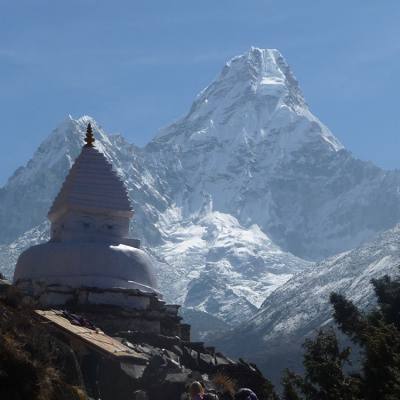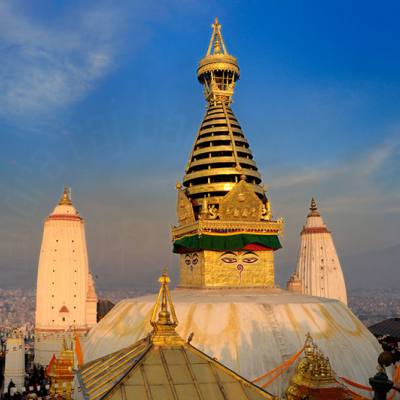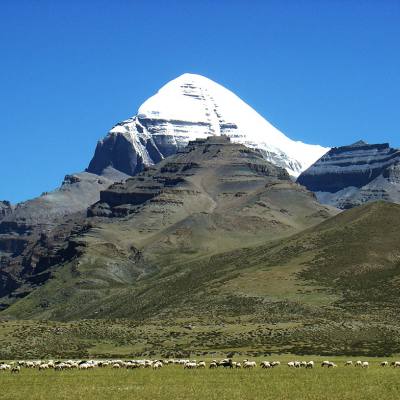In Lhasa:
Lhasa, Tibet’s capital (3,750 m) is a cultural city with a history going 1,300 years. The magnificent Potala Palace, former seat of the Dalai Lamas, prsides over the city. Built in 1645 on the top of a hill, the palace containing more than 1,000 rooms, 10,000 shrines and 200,000 religious statues commands a majestic presence almost in the middle of the Lhasa city.
The old part of Lhasa city revolves around the Jokhang Temple and the Barkhor Bazaar is the heart of Lhasa with much hustle and bustle where the Tibetans buy their day to day necessities. It is the Barkhor Bazaar which offers the true representative lifestyle of the urban Tibetans where majority of western visitors love to stay and spend most of their time.
The Jokhang Temple, built in the 17th century, is the holiest Buddhist shrine in Tibet. Its mural paintings, finely worked golden roofs and other works art works are something never to miss out. At a little distance from the old city centre, Lhasa is also a modern capital of concrete high-rise, fancy departmental stores and wide boulevards.
Norbulinka consists of wooded greenery and three palaces once used by the Dalai Lamas as a summer palace.
Drepung Monastery, built in 1416, lies about 10 km north-west from the city. It is the largest monastery in Tibet, once sheltering 10,000 monks. The Sera Monastery, about 5 km to the north of Lhasa, is another important centre of Buddhist learning. Debating among the red-robed monks amidst the serene surroundings in the afternoon is a never to miss scene in the monastery.
Out of Lhasa & around Tibet:
Shigatse (3,900 m) lies 280 km to the south-west of Lhasa. It is Tibet’s second-largest city and has a 500-year-old history. The highway runs alongside the Yarlung Tsangpo (Brahmaputra river) passing through narrow gorges and broad river valleys. The drive is full of scenic views with farmers plowing their fields with yaks, sheep grazing on the vast plains, awesome sand dunes and rocky hills in the distance. Yamadroke (turquoise blue) lake is a beautiful lake, we pass by on our way to Gyantse from Lhasa. A picnic by the side of the lake is always a good idea depending on the weather condition. En route we cross over high passes of Khamba-la (4790 m) and Karo-la (5,050 m). The view of Yamadroke lake on one side and on the other the Yarlung Tsangpo from the Khambala is highly picturesque.
Gyantse (3,800 m) is located 260 km south-west of Lhasa. It was a major booming town on the legendry India-Tibet trading route. Gyantse’s major attractions are the Kumbum Stupa which is 32 m high and contains 77 rooms and 100,000 images of the Buddha. Phalkor Choede and Gyantse Dzong (fort)(built atop a massive rock at the centre of the town.
The most beautiful monastery in Tibet ‘Tashilhumpu Monastery’, built in 1447 houses a 26-metre high golden statue of Maitreya (the future Buddha). Other buildings contain images of Sakyamuni (the mortal Buddha born in Nepal in about 600 BC).
Tsedang (210 km south-east of Lhasa) is known as the cradle of Tibetan civilization. The ancient town offers a number of side trips that illustrate Tibet’s early history. It is the ancient capital of the Yarlung kings who established the Tibetan nation. The Chongye (tombs of ancient kings), Yumbulakhang (the castle of Yumbu Lakhang - the oldest known dwelling in Tibet, reputedly the home of the Yarlong kings) and Thandruk Monastery (one of the three royal temples built by Trisong Detsen) are the major sights.
Namtso Lake (4,700 m)(1,940 Sq km) lies 250 km north-west of Lhasa with a good raod connection. It is the highest & biggest salt lake in the world.
Mt Kailash and Manasarovar in the far western Tibet are intensely sacred pilgrimage sites for the Hindu, Buddhist, Jain and Bon Po. It is almost 1,260 km west of Lhasa through the typical highly scenic rugged Tibetan landscape.

 98510 22507 (Mahendra)
98510 22507 (Mahendra)




